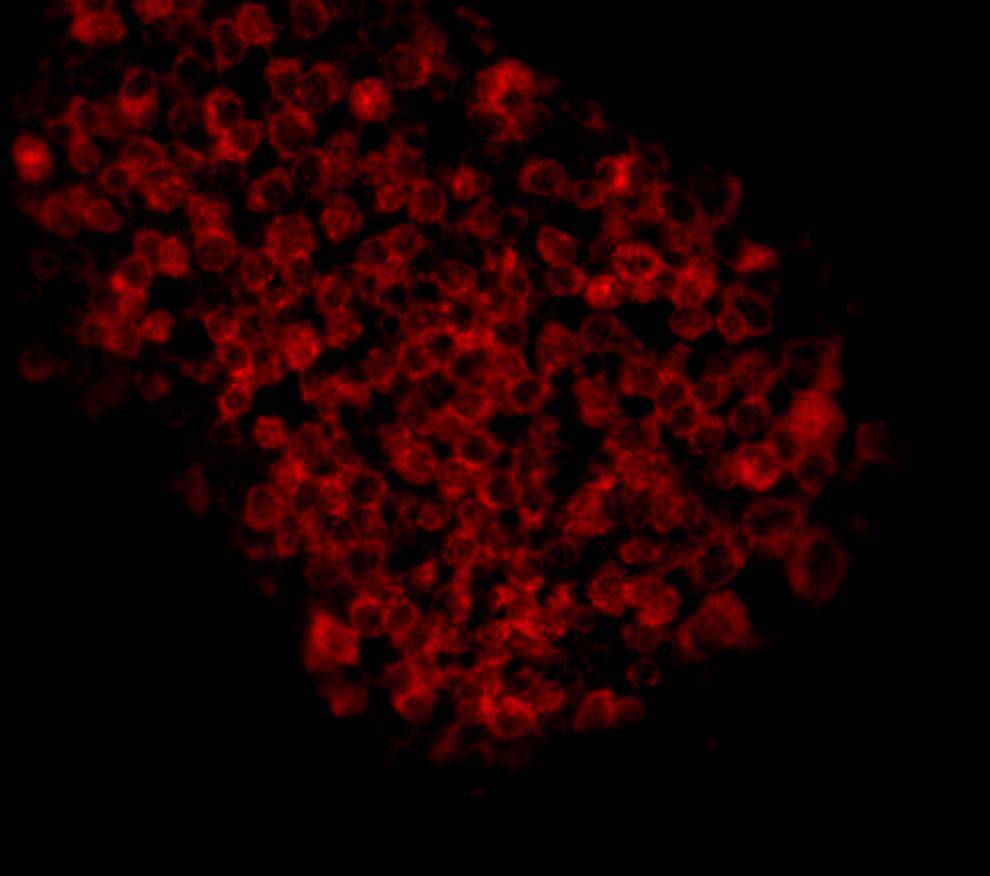EpCAM Mouse Monoclonal Antibody [3-E1-E2]

cat.: EM1111
| Product Type: | Mouse monoclonal IgM, primary antibodies |
|---|---|
| Species reactivity: | Human, Mouse |
| Applications: | WB, IF-Cell |
| Clonality: | Monoclonal |
| Clone number: | 3-E1-E2 |
| Form: | Liquid |
| Storage condition: | Store at +4℃ after thawing. Aliquot store at -20℃ or -80℃. Avoid repeated freeze / thaw cycles. |
| Storage buffer: | 1*PBS (pH7.4), 0.2% BSA, 40% Glycerol. Preservative: 0.05% Sodium Azide. |
| Concentration: | 2ug/ul |
| Purification: | Protein L affinity purified. |
| Molecular weight: | Predicted band size: 35 kDa |
| Isotype: | IgM |
| Immunogen: | Recombinant protein within human EP-CAM aa 24-265 (Extracellular). |
| Positive control: | Hela cell lysate, NIH/3T3 cell lysate, MCF-7 cell lysate, D3, A431. |
| Subcellular location: | Cell membrane |
| Recommended Dilutions:
WB IF-Cell |
1:1,000-1:2,000 1:100-1:200 |
| Uniprot #: | SwissProt: P16422 Human | Q99JW5 Mouse |
| Alternative names: | 17 1A 323/A3 Adenocarcinoma associated antigen Adenocarcinoma-associated antigen Antigen identified by monoclonal AUA1 AUA1 CD326 CD326 antigen Cell surface glycoprotein Trop 1 Cell surface glycoprotein Trop 2 Cell surface glycoprotein Trop-1 CO 17A CO17 1A CO17A DIAR5 EGP 2 EGP EGP2 EGP314 EGP40 Ep CAM Ep-CAM EPCAM EPCAM_HUMAN EpCAM1 Epithelial cell adhesion molecule Epithelial Cell Adhesion Molecule Intracellular Domain (EpCAM-ICD) Epithelial cell surface antigen Epithelial cellular adhesion molecule Epithelial glycoprotein 1 Epithelial glycoprotein 314 Epithelial glycoprotein ESA GA733 1 GA733 2 GA733-2 gastrointestinal tumor-associated antigen 2, 35-KD glycoprotein gp4 hEGP 2 hEGP314 HNPCC8 Human epithelial glycoprotein 2 KS 1/4 antigen KS1/4 KSA Ly74 Lymphocyte antigen 74 M1S 1 M1S2 M4S1 Major gastrointestinal tumor associated protein GA733 2 Major gastrointestinal tumor-associa...... |
Images

|
Fig1:
Western blot analysis of EpCAM on different lysates using anti- EpCAM antibody at 1/1000 dilution. Positive control: Lane 1: Hela cell lysate Lane 2: NIH/3T3 cell lysate Lane 3: MCF-7 cell lysate |

|
Fig2: ICC staining EpCAM in D3 cells (red). Cells were fixed in paraformaldehyde, permeabilised with 0.25% Triton X100/PBS. |

|
Fig3: ICC staining EpCAM in A431 cells (green). The nuclear counter stain is DAPI (blue). Cells were fixed in paraformaldehyde, permeabilised with 0.25% Triton X100/PBS. |

|
Fig4:
Immunocytochemistry analysis of NIH/3T3 cells labeling EpCAM with Mouse anti-EpCAM antibody (EM1111) at 1/500 dilution. Cells were fixed in 4% paraformaldehyde for 20 minutes at room temperature, permeabilized with 0.1% Triton X-100 in PBS for 5 minutes at room temperature, then blocked with 1% BSA in 10% negative goat serum for 1 hour at room temperature. Cells were then incubated with Mouse anti-EpCAM antibody (EM1111) at 1/500 dilution in 1% BSA in PBST overnight at 4 ℃. Goat Anti-Mouse IgG H&L (iFluor™ 488, HA1125) was used as the secondary antibody at 1/1,000 dilution. PBS instead of the primary antibody was used as the secondary antibody only control. Nuclear DNA was labelled in blue with DAPI. beta Tubulin (ET1602-4, red) was stained at 1/100 dilution overnight at +4℃. Goat Anti-Rabbit IgG H&L (iFluor™ 594, HA1122) was used as the secondary antibody at 1/1,000 dilution. |
Note: All products are “FOR RESEARCH USE ONLY AND ARE NOT INTENDED FOR DIAGNOSTIC OR THERAPEUTIC USE”.